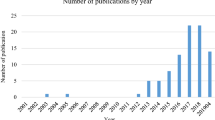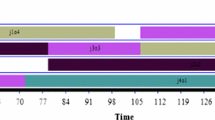Abstract
Two key decisions in designing cellular manufacturing systems are cell formation and layout design problems. In the cell formation problem, machine groups and part families are determined while in the facility layout problem the location of each machine in each cell (intra-cell layout) and the location of each cell (inter-cell layout) are decided. Owing to the fact that there are interactions between two problems, cell formation and layout design problem must be tackled concurrently to design a productive manufacturing system. In this research, two problems are investigated concurrently. Some important and realistic factors such as inter-cell layout, intra-cell layout, operations sequence, part demands, batch size, number of cells, cell size, and variable process routings are incorporated in the problem. The problem is formulated as a mathematical model. Three different methods are described to solve the problem: multi-objective scatter search (MOSS), non-dominated genetic algorithm (NSGA-II), and the ε-constraint method. The methods are employed to solve nine problems generated and adopted from the literature. Sensitivity analysis is accomplished on the parameters of the problem to investigate the effects of them on objective function values. The results show that the proposed MOSS algorithm performs better than NSGA-II and produces better solutions in comparison to multi-stage approaches.
Similar content being viewed by others
References
Wemmerlov U, Johnson DJ (1997) Cellular manufacturing at 46 user plants: implementation experiences and performance improvements. Int J Prod Res 35:2–49
Wemmerlov U, Johnson DJ (2000) Empirical findings on manufacturing cell design. Int J Prod Res 38:481–507
Wemmerlov U, Hyer NL (1986) Procedures for the part family/machine group identification problem in cellular manufacture. J Oper Manag 6:125–147
Singh N (1993) Design of cellular manufacturing systems: an invited review. Eur J Oper Res 69:284–291
Heragu SS (1992) Recent models and techniques for solving the layout problem. Eur J Oper Res 57:136–144
Jajodia S, Minis I, Harhalakis G, Proth J (1992) CLASS: computerized layout solution using simulated annealing. Int J Prod Res 30(l):95–108
Selim HM, Askin RG, Vakharia AJ (1998) Cell formation in group technology: review, evaluation and directions for future research. Comput Ind Eng 34(1):3–20
Papaioannou G, Wilson JM (2010) The evolution of cell formation problem methodologies based on recent studies (1997–2008): review and directions for future research. Eur J Oper Res 206:509–521
Miltenburg J, Zhang W (1991) A comparative evaluation of nine well-known algorithms for solving the cell formation problem in group technology. J Oper Manag 10(1):44–72
Shafers M, Rogers DF (1993) Similarity and distance measures for cellular manufacturing. Part II. An extension and comparison. Int J Prod Res 31(6):1315–1326
Yin Y, Yasuda K (2006) Similarity coefficient methods applied to the cell formation problem: a taxonomy and review. Int J Prod Econ 101:329–352
Hassan MMD (1995) Layout design in group technology manufacturing. Int J Prod Econ 38:173–188
Arvindh B, Irani SA (1994) Cell formation: the need for an integrated solution of the subproblems. Int J Prod Res 32(5):1197–1218
Vakharia AJ, Wemmerlov U (1990) Designing a cellular manufacturing system: a materials flow approach based on operation sequences. IIE Trans 22(1):84–97
Akturk MS, Balkose HO (1996) Part–machine grouping using a multi-objective cluster analysis. Int J Prod Res 34(8):2299–2315
Chan FTS, Lau KW, Chan LY, Lo VHY (2008) Cell formation problem with consideration of both intracellular and intercellular movements. Int J Prod Res 46(10):2589–2620
Dahel NE (1995) Design of cellular manufacturing systems in tandem configuration. Int J Prod Res 33(8):2079–2095
Heragu SS, Kakuturi SR (1997) Grouping and placement of machine cells. IIE Trans 29(7):561–571
Alfa SA, Chen M, Heragu S (1992) Integrating the grouping and layout problems in cellular manufacturing systems. Comput Ind Eng 23:54–58
Liao TW, Chen LJ, Chen ZH, Coates ER (1996) A comparison of two approaches for designing line type cellular manufacturing systems. Integr Manuf Syst 7(1):6–15
Irani SA, Cavalier TM, Cohen PH (1993) Virtual manufacturing cells: exploiting layout design and intercell flows for the machine sharing problem. Int J Prod Res 31(4):791–810
Akturk MS (1996) A note on the within-cell layout problem based on operation sequences. Prod Plan Control 7(1):99–103
Harhalakis G, Lu T, Minis I, Nagi R (1996) A practical method for design of hybrid-type production facilities. Int J Prod Res 34(4):897–918
Bazargan-Lari M, Kaebernick H, Harraf A (2000) Cell formation and layout designs in a cellular manufacturing environment a case study. Int J Prod Res 38(7):1689–1709
Sarker BR, Xu Y (2000) Designing multi-product lines: job routing in cellular manufacturing systems. IIE Trans 32:219–235
Urban TL, Chiang W, Russell RA (2000) The integrated machine allocation and layout problem. Int J Prod Res 38(13):2911–2930
Lee S, Chiang C (2001) A cut-tree-based approach for clustering machine cells in the bidirectional linear flow layout. Int J Prod Res 39(15):3491–3512
Lee S, Chiang C (2002) Cell formations in the uni-directional loop material handling environment. Eur J Oper Res 137(2):401–420
Dixit AR, Mishra PK (2010) Ex-CLASS: Extended Cell formation and Layout Selection considering production parameters with Sequence data. Int J Prod Dev 10:180–200
Akturk MS, Turkcan A (2000) Cellular manufacturing system design using a holonistic approach. Int J Prod Res 38(10):2327–2347
Ahi A, Aryanezhad MB, Ashtiani B, Makui A (2009) A novel approach to determine cell formation, intracellular machine layout and cell layout in the CMS problem based on TOPSIS method. Comput Oper Res 36:1478–1496
Krishnan KK, Mirzaei S, Venkatasamy V, Pillai VM (2011) A comprehensive approach to facility layout design and cell formation. Int J Adv Manuf Technol. doi:10.1007/s00170-011-3523-z
Gupta Y, Gupta M, Kumar A, Sundaram C (1996) A genetic algorithm-based approach to cell composition and layout design problems. Int J Prod Res 34(2):447–482
Logendran R (1991) Impact of sequence of operations and layout of cells in cellular manufacturing. Int J Prod Res 29(2):375–390
Wu X, Chu CH, Wang Y, Yan W (2006) Concurrent design of cellular manufacturing systems: a genetic algorithm approach. Int J Prod Res 44(6):1217–1241
Paydar MM, Mahdavi I, Sharafuddin I, Solimanpur M (2010) Applying simulated annealing for designing cellular manufacturing systems using MDmTSP. Comput Ind Eng 59:929–936
Chiang C, Lee S (2004) A genetic-based algorithm with the optimal partition approach for the cell formation in bi-directional linear flow layout. Int J Comput Integr Manuf 17(4):364–375
Ming LC, Ponnambalam SG (2008) A Hybrid GA/PSO for the Concurrent Design of Cellular Manufacturing System. 2008 I.E. International Conference on Systems, Man and Cybernetics, (pp. 1855–1860)
Mahdavi I, Mahadevan B (2008) CLASS: an algorithm for cellular manufacturing system and layout design using sequence data. Robot Comput Integr Manuf 24:488–497
Paydar MM, Mahdavi I, Solimanpur M, Tajdin A (2008) Solving a new mathematical model for cellular manufacturing system: fuzzy goal programming. Proceedings of the 2008 I.E. IEEM, (pp. 1224–1228)
Defersha FM, Chen M (2006) A comprehensive mathematical model for the design of cellular manufacturing systems. Int J Prod Econ 103:767–783
Tavakkoli-Moghaddam R, Safaei N, Sassani F (2008) A new solution for a dynamic cell formation problem with alternative routing and machine costs using simulated annealing. J Oper Res Soc 59:443–454
Kioon SA, Bulgak AA, Bektas T (2009) Integrated cellular manufacturing systems design with production planning and dynamic system reconfiguration. Eur J Oper Res 192:414–428
Haimes Y, Lasdon L, Wismer D (1971) On a bicriterion formulation of the problems of integrated system identification and system optimization. IEEE Trans Syst Man Cybern 1:296–297
Chankong V, Haimes Y (1983) Multiobjective decision making: theory and methodology. Elsevier, New York
Glover F (1997) Heuristics for integer programming using surrogate constraints. Decis Sci 8:156–166
Marti R, Laguna M, Glover F (2006) Principles of scatter search. Eur J Oper Res 169:359–372
Aramoon Bajestani M, Rabbani M, Rahimi-Vahed AR, Baharian Khoshkhou G (2009) A multi-objective scatter search for a dynamic cell formation problem. Comput Oper Res 36:777–794
Tavakkoli-Moghaddam R, Javadian B, Khorrami A, Gholipour-Kanani Y (2010) Design of a scatter search method for a novel multi-criteria group scheduling problem in a cellular manufacturing system. Expert Syst Appl 37:2661–2669
Tavakkoli-Moghaddam R, Ranjbar-Bourani M, Amin GR, Siadat A (2011) A cell formation problem considering machine utilization and alternative process routes by scatter search. J Intell Manuf. doi:10.1007/s10845-010-0395-2
Rahimi-Vahed AR, Rabbani M, Tavakkoli-Moghaddam R, Torabi SA, Jolai F (2007) A multi-objective scatter search for a mixed-model assembly line sequencing problem. Adv Eng Inform 21:85–99
Wang X, Tang J, Yung K (2009) Optimization of the multi-objective dynamic cell formation problem using a scatter search approach. Int J Adv Manuf Technol 44:318–329
Deb K, Pratap A, Agarwal S, Meyarivan T (2002) A fast and elitist multiobjective genetic algorithm: NSGA-II. IEEE Trans Evol Comput 6(2):182–197
Srinivas N, Deb K (1994) Multiobjective function optimization using nondominated sorting genetic algorithms. Evol Comput 2(3):221–248
Kazerooni ML, Luong HS, Abhary K (1997) A genetic algorithm based cell design considering alternative routing. Int J Comput Integ Manuf Syst 10:93–107
Nagi R, Harhalakis G, Proth J (1990) Multiple routings and capacity considerations in group technology applications. Int J Prod Res 28(12):1243–1257
Chan FTS, Lau KW, Chan PLY, Choy KL (2006) Two-stage approach for machine-part grouping and cell layout problems. Robot Comput Integr Manuf 22:217–238
Author information
Authors and Affiliations
Corresponding author
Rights and permissions
About this article
Cite this article
Jabal-Ameli, M.S., Moshref-Javadi, M. Concurrent cell formation and layout design using scatter search. Int J Adv Manuf Technol 71, 1–22 (2014). https://doi.org/10.1007/s00170-013-5342-x
Received:
Accepted:
Published:
Issue Date:
DOI: https://doi.org/10.1007/s00170-013-5342-x




